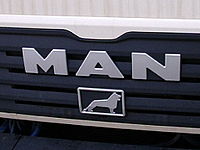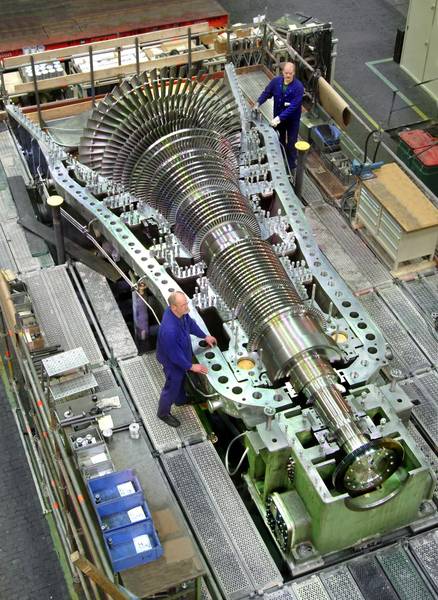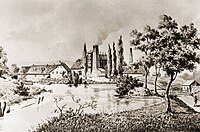 | |
| Type | Public company: Societas Europaea (FWB: MAN) |
|---|---|
| Industry | Manufacturing, automotive industry, marine engineering |
| Founded | 1758[1] |
| Headquarters | Munich, Bavaria, Germany |
| Number of locations | manufacturing facilities in the Ruhr area, Augsburg, and outside Germany |
| Area served | Worldwide |
| Key people | Georg Pachta-Reyhofen (CEO), Ferdinand Piëch (Chairman of the supervisory board) |
| Products | Trucks, buses, diesel and other engines, turbomachinery |
| Revenue | €12.03 billion (2009)[2] |
| Operating income | ▼ (€214 million) (2009)[2] |
| Profit | ▼ (€270 million) (2009)[2] |
| Total assets | €15.90 billion (2009)[2] |
| Total equity | €5.129 billion (2009)[2] |
| Employees | 47,740 (end 2009)[2] |
| Subsidiaries | MAN Nutzfahrzeuge AG, MAN Diesel & Turbo SE MAN Latin America, Renk AG (76%) |
| Website | MAN.eu |
MAN SE, formerly MAN AG, is a mechanical engineering company and parent company of the MAN Group.[3] MAN SE is based in Munich, in the German State of Bavaria. Its primary output is for the automotive industry, particularly heavy trucks. Further activities include the production of diesel engines for various applications, like ship propulsion, and also turbomachinery.[4]
MAN supplies trucks, buses,[4] diesel engines,[4] turbomachinery,[4] as well as industrial services. MAN SE is one of the top 30 companies listed on the German stock exchange (DAX).[4] It also is the oldest company within the DAX. The company celebrated its 250th anniversary in 2008.[4][5] In 2008, its 51,300 employees generated annual sales of around €15 billion in 120 different countries. The company has joint ventures and other cooperations with local companies in India, Poland, Turkey, China and the United States.
Corporate overview
The MAN Group currently operates its production output through three main subsidiaries, with each subsidiary's output destined for differing geographic locations.
- MAN Nutzfahrzeuge AG (English: MAN Commercial Vehicles) is one of Europe's leading commercial vehicle manufacturers.
- MAN Diesel & Turbo SE is a world leader in large diesel ship engines, stationary engines and turbomachinery.
- MAN Latin America has a leading position in heavy trucks in Brazil.
History

Foundation
MAN traces its origins back to 1758, when the "St. Antony" ironworks commenced operation in Oberhausen, as the first heavy-industry enterprise in the Ruhr region. In 1808, the three ironworks "St. Antony", "Gute Hoffnung" (English: "Good Hope"), and "Neue Essen" merged, to form the Hüttengewerkschaft und Handlung Jacobi (English: "Iron Mining and Trading Company"), Oberhausen, which was later renamed Gute Hoffnungshütte (GHH).[1]
In 1840, the German engineer Ludwig Sander founded in Augsburg the first predecessing enterprise of MAN in Southern Germany: the “Sander’sche Maschinenfabrik”. It firstly became the “C. Reichenbach’sche Maschinenfabrik”, which was named after the pioneer of printing machines Carl August Reichenbach, and later on the “Maschinenfabrik Augsburg” [1].
In 1908, the Vereinigte Maschinenfabrik Augsburg und Maschinenbaugesellschaft Nürnberg A.G., Augsburg ("United Machine Works Augsburg and Nuremberg Ltd."), which came into being through the 1898 merger of Maschinenbau-AG Nürnberg (founded 1841), and the Maschinenfabrik Augsburg AG (founded 1840) was renamed Maschinenfabrik Augsburg Nürnberg AG, Augsburg, or in short M.A.N. While the focus initially remained on ore mining and iron production in the Ruhr region, machine building became the dominating branch of business in Augsburg and Nuremberg. As director of the “Maschinenfabrik Augsburg” Heinrich von Buz created of a small business with 400 employees a major enterprise with 12,000 workpeople. Locomotion, propulsion and steel building were the big topics of this phase. The early predecessors of MAN were responsible for numerous technological innovations, the success of the early MAN entrepreneurs and engineers was based on a great openness towards new technologies. They constructed the suspension railway of Wuppertal (“Wuppertaler Schwebebahn”) and the first spectacular steel bridges like the Großhesseloher Brücke in Munich in 1857 and the railway bridge of Müngsten between 1893 and 1897.
The invention of the rotary printing press allowed the copious printing of books and newspapers and since 1893, Rudolf Diesel puzzled for four years with future MAN engineers in a laboratory in Augsburg until his first Diesel engine was completed and fully functional.
During 1921, the majority of M.A.N. was taken over by the Gutehoffnungshütte Actienverein für Bergbau und Hüttenbetrieb, Sterkrade (GHH), (founded 1873).[1] Through well-directed equities and acquisitions of processing industries – e. g. Deutsche Werft (1918), Ferrostaal (1921), Deggendorfer Werft und Eisenbau (1924) – MAN advanced to a nationwide operating enterprise.
Crisis and World War II
At the same time the GHH’s economic situation worsened. The causes for this were amongst others the Reparation after World War I, the occupation of the Ruhr region and the world economic crisis. In only two years the number of the MAN employees sank from 14,000 in the year 1929/30 to 7,400 in 1931/32. While the civil business was largely collapsing, the military business increased with the armament under the national socialist regime. GHH/MAN enterprises supplied diesel engines for submarines, panzers, cylinders for projectiles and cannonry of every description.
The MAN works in Nuremberg have often been target of massive bomb attacks during World War II, because 40 percent of all Panther panzers built in Germany were produced there.[1]
Postwar period
After the end of World War II the allies deconcentrated the GHH group. A vertical integration in which mining, iron and steel production are consolidated was not allowed anymore. The “Gutehoffnungshütte”, together with the MAN firms of Southern Germany, therefore concentrated on engineering, plant construction, commercial vehicles and printing machines. This process has been supported by strategic acquisitions and dispositions; one the most important was the take-over of the truck and bus division of the commercial vehicles manufacturer Büssing (1971), the disposition of the shares of the shipyard Deutsche Werft (1966/67) and the acquisition of the printing machine producer Faber&Schleicher as well as its fusion to MAN Roland Druckmaschinen AG (1979).[1]
In 1982/83 the “Gutehoffnungshütte” plunged into a deep corporate crisis. The entreprised suffered from the late effects of the second oil crises and a bad economic situation. This was particularly displayed by the dramatic downturn of the commercial vehicles sales figures. Besides external factors, the chief course of these problems was the obsolete company structure with extensive cross-subsidisation between the divisions. At this time the former director of GHH presented a reclamation concept that envisioned a complete consolidation of the subsidiary with the holding company. This concept encountered great resistance with GHH’s major shareholders Allianz AG and Commerzbank. The media speculated about a “Bavarian conspiracy” against the Management in Oberhausen.[1]
In 1986, with Klaus Götte, the group got a new company structure and became a contractual group with economically independent division at several locations. This was also attended by the transferring of the MAN headquarters from Oberhausen to Munich and by the new company name MAN AG.
Rudolf Rupprecht repelled a takeover attempt in 2003. Furthermore, the disposition of the 50-percent share of the SMS Group and the strengthening of the turbomachinery division through the takeover of Sulzer Turbo induced MAN’s focusing process.
In September 2006, MAN produced an offer for the take-over of the Swedish competitor Scania. The European Commission approved the takeover on December, 14. Nevertheless, MAN voluntarily withdrew the offer on January 23, 2007, after Scania’s major shareholders VW and the influential Wallenberg family had declined the offer. On December 24, 2008, MAN published to possess further stock options of Scania and to therefore maintain more than 20 percent of the voting rights.
In 2008, the MAN group celebrated its 250 years anniversary with numerous events, like exhibitions in several museums, a vintage car tour with the motto “MAN on the road again” and a great anniversary gala. At the beginning of December 2008 MAN took over the company VW Truck and Bus Brazil and changed the firm’s name to MAN Latin America. Therewith, MAN now is market leader in Brazil with a market share of 30 percent.
Since May 2009, the group is incorporated as European corporation MAN SE. [6] In July 2009 MAN published to merge the two divisions MAN Turbo and MAN Diesel into one business area called Power Engineering. In addition the group contracted a strategic partnership with the Chinese truck manufacturer Sinotruk. In the course of this focusing process many smaller subsidiaries and division have been sold.
In 2009, investigators of the Munich Prosecution Department uncovered a corruption affair, in which MAN has been corrupting business partners and governments in over 20 countries during the years 2001 to 2007 to get large orders for buses and trucks. MAN CEO Håkan Samuelsson and further Board Members had to resign. The board of directors appointed Dr.-Ing. Georg Pachta-Reyhofen, the former CEO of MAN Diesel, as successor. On December 17, 2009 Pachta-Reyhofen was assigned as speaker of the board and CEO of MAN SE by the board of directors.
Holdings
Subsidiaries


- MAN Nutzfahrzeuge AG
- (roughly 50% of overall sales; 88% of division sales come from European market)[7]
- Commercial vehicles: trucks (61% of group sales), aftermarket parts and service (18%), MAN AG Buses and Neoman Buses (14%), engines and components (7%)
- MAN Diesel & Turbo SE
- (formed after the merger of MAN Diesel SE and MAN Turbo AG)[8]
- 2-stroke and 4-stroke diesel and petrol engines: large marine and stationary diesel engines, engines for vehicles, industrial applications, power stations, yachts, passenger ships, ships, and work-boats (tankers, tugboats, icebreakers), railways. Turbomachines: compressors and turbines for process industry and power generation worldwide; used in oil and natural gas, refinery, chemical and petrochemical, fertilizers, industrial gases, iron and steel processing and mining, power generation applications.
- MAN Latin America
- former Volkswagen Trucks and Buses (Volkswagen Caminhões e Ônibus Ltda.) [9]
- Renk AG
- (76% stake)
- Vehicle Transmissions, Industrial Gear Units, Marine Gear Units, Slide Bearings, Couplings[10]
- Sinotruk
- (25% stake acquired 24 July 2009)
[edit] Investments
- Ferrostaal AG
- (30% stake, remainder owned by International Petroleum Investment Company. Former MAN subsidiary)
- Industrial services: projecting, delivery, assembly, including steel-based structures
MAN Nutzfahrzeuge products
Trucks and military vehicles
- LE Series
- FE Series
- HX Series - military
- SX Series - military
- TGL Series, with hybrid trucks ( MAN TGL OPTISTRANG and TGL EDA).
- TGM Series
- TGA Series
- TGX/S Series - variant of TGS model was used for Dakar Rally
- ERF - a UK-only brand, bought from Western Star (which soon after became part of Freightliner LLC) in 2000
- Hazmat tender
- Angloco foam fire tender
- Command unit
Buses
- Lion's City city- / inter-urban bus (includes hybrid electric bus version with supercapacitors)
- Lion's Classic city- / inter-urban bus
- Lion's Regio inter-urban bus
- Americana city-bus
- Fortuna inter-urban bus
- NM 223/283
- NL/ÜL 313 / 363 F (LF)
- NL 202 / 232 (LF)
- NL 233 / 233 / 263 (LF)
- NL 262 R
- NL 273 F
- NG 263 / NG 313 / NG 363 F (LF)
- ND 243 F
- 10.225 FOCL midi coach
- 11.190 HOCL midi (LF)
- 12.220 HOCL
- 14.280 HOCL
- 12.220 HOCL-NL
- 14.220 HOCL-NL
- 16.200
- 18.220 / 18.260 / 18.280 HOCL-SL
- 18.220 / 18.260 / 18.280 / 18.310 / 18.360 HOCL-SÜ
- 18.220 / 18.240 / 18.260 / 18.310 HOCL-NL (LF)
- 18.260 / 18.310 / 18.360 / 18.410 / 18.460 HOCL
- 24.310 / 24.360 / 24.410 / 24.460 HOCLN
- 28.310 HGOCL






Tidak ada komentar:
Posting Komentar